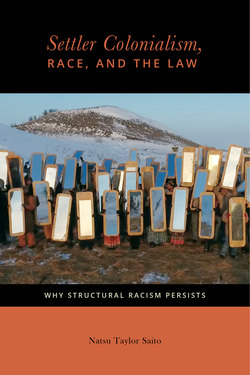Читать книгу Settler Colonialism, Race, and the Law - Natsu Taylor Saito - Страница 44
На сайте Литреса книга снята с продажи.
Assimilation
ОглавлениеRacialization leads, perhaps counterintuitively, to the nullification of identity. The “race problem” having been constructed as one of difference, the “race solution” becomes the elimination of difference. Framed in terms of assimilation, this solution has been, and continues to be, a critical strategy of colonization because if Native peoples can be absorbed into the general population, their land claims and their challenges to settler hegemony disappear with them.110 Thus, for example, Russel Barsh reports that in 1979 opponents of Catawba land claims in South Carolina argued in congressional hearings that the claims should be dismissed because the Catawbas “are no longer an entity, which is good. They have been absorbed into the mainstream of life.”111
Assimilationism provided the ideological foundation for the allotment policy of the late 1880s that purported to facilitate the transformation of Indians into independent farmers. As historian Blue Clark notes, “reformers” of this era urged “the Indian’s absorption ‘into the common life of the people of the United States’” so that they would no longer “block American progress and stand in the way of the public good.”112 As part of this “civilizing mission,” US citizenship was unilaterally conferred upon American Indians in 1924, making it that much easier for them to be viewed and treated, and to see themselves, as racial minorities rather than sovereign peoples.113
In the meantime, Indigenous spiritual practices had been outlawed, “a measure expressly intended to eradicate all vestiges of the traditions that afforded cohesion and continuity to native cultures.”114 American Indians were subjected to criminal penalties for accessing sacred sites, collecting and using natural medicines, or performing the ceremonies required to maintain balance and harmony in their worlds.115 These prohibitions were not officially rescinded until 1978, when the American Indian Religious Freedom Act was passed, and Indigenous spiritual realities remain under attack as governmental authorities and the courts consistently find a “higher” use for sacred sites and require Indians to “prove” that their practices deserve protection by virtue of being sufficiently analogous to the religious rituals of the dominant culture.116
Cultural continuity was intentionally disrupted through the forcible removal of American Indian children from their homes and communities. In the late nineteenth century, federal officials began sending American Indian children to remote boarding schools that were, in fact, juvenile prisons.117 From about 1890 to 1970, approximately half of the Native children in each generation were subjected to these institutions, where, in the name of “civilizing” them, the students were stripped of all vestiges of their cultures, forbidden to speak their languages, and taught that all things Indian were unworthy.118 Subjected to harsh corporal punishment, sexual predation, involuntary labor, malnutrition, and communicable diseases, during some periods up to half the children died.119 For these reasons, Indian “education” could quite appropriately be considered one of the strategies of indirect killing discussed earlier. Predictably, most of the survivors of these institutions suffered—and continue to suffer, as do their children and grandchildren—the effects of sustained traumatic abuse.120
A related strategy for assimilating Indigenous peoples out of existence has been the widespread termination of parental rights and the “out-adoption” of American Indian children. Facilitated by an Indian Adoption Program organized by the Child Welfare League of America in cooperation with the BIA, by the early 1970s perhaps one-third of all American Indian children were in adoptive homes, foster care, or institutions, and 90 percent of the placements were in non-Indian homes.121 Just as the stated objective of the boarding schools had been to “kill the Indian, save the man” in each child, the adoption program was explicitly intended to preclude these children from knowing their cultures, thereby eviscerating the ability of their nations to survive.122 As such, these policies were explicitly genocidal, designed—in the words of the Genocide Convention—“to destroy, in whole or in part, a national, ethnical, racial or religious group, as such” by “forcibly transferring children of the group to another group.”123
Eventually congressional hearings “documented the existence of a crisis in the Indian family of sufficient proportion to threaten tribal survival,” in the words of law professor Barbara Atwood,124 and resulted in passage of the 1978 Indian Child Welfare Act (ICWA). Nonetheless, these practices continue. In March 2015, for example, a federal judge found South Dakota officials still removing hundreds of Indian children from their homes every year, after hearings that routinely took just a few minutes.125 Native families were not allowed to present testimony and often did not know why their children were taken. Eighty percent of these children were being placed in White foster homes, illustrating the assimilationist presumptions that underlie assessments of children’s “best interests.”126
Ultimately, of course, assimilation is futile because its success is “never dependent on indigenous performance” but instead requires absorption by settler society.127 Such absorption does not happen, except in isolated instances, because the maintenance of settler privilege requires unassimilable difference. In the meantime, however, assimilationist ideology “allows indigenous people to be envisaged as only temporarily excluded” and supports settler claims to be “ultimately representing all residents.”128 Simultaneously, it paves the way for vilifying and criminalizing those Indigenous peoples who are either structurally prevented from assimilating or do not wish to do so.
The assimilationist model allows the dysfunction found in all impoverished, colonized, and traumatized communities to be, in this case, attributed to Indians being “drunk,” “lazy,” “violent,” or “incompetent.” It justifies high rates of incarceration and the continued removal of Indian children from their communities.129 In turn, such vilification and criminalization are “crucial to the disavowal of the inherently political character of indigenous demands.”130 In sum, within the dominant narrative, American Indians may be assimilated out of existence and, therefore, have no legitimate claims against the settler state, or they may be insufficiently assimilated (“civilized”) to have such claims.
